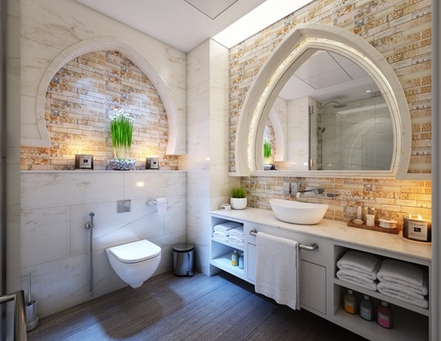
Because most household water use happens in the bathroom, it’s not really surprising that households pay particular attention to saving water in there. Some water-saving options can be purchased—good examples include low-flow taps and shower heads. Other options, on the other hand, are considered as methods to save water. Examples of water-saving methods include rainwater collection and reuse of grey water. Information on these options and methods are highlighted below.
Low-Flow Taps and Fixtures
The first things you need to invest in order to achieve a greener bathroom are low-flow taps and fixtures, and they do not cost much.
This type of tap is easy to identify—it is known for its filtered tip called an aerator, which determines max tap flow rate. The aerator restricts flow rate from 2.5 gallons per minute or gpm to as low as 0.5 gpm.
A low-flow showerhead, another amazing investment, can reduce water use by up to sixty percent. To gain the most benefit from this particular fixture, make sure to choose one that has a <2.5 gpm flowrate from either of these types: laminar-flow and aerating.
As its name suggests, an aerating showerhead incorporates air to water, and this results in a misty spray. A laminar-flow showerhead, on the other hand, produces water streams. They are great for anyone currently living in a humid climate since they do not produce much moisture and steam.
Flushing Frugally with Dual-Flush Toilets
Many homeowners are already aware that toilets use a lot of water every flush, and this has led to them replacing their toilets and only flushing when necessary.
One upgrade to your old toilet is a low-flow toilet. While water-saving, the amount of water they use for each flush might not be enough to push human wastes down. Enter the dual-flush toilet, which, true to its name, features two flush options. The first option is the low-flow flush, and the second option is the robust flush.
Displacing Toilet Tank Space
Toilet tank space can be minimised by placing something inside the tank. This object should be durable (not made of glass) and not be prone to degrading or corroding. With this in mind, good choices include a brick and a crushed plastic jug.
Other Ways of Cutting Down Wasted Water in the Toilet
Avoid tossing and flushing solid objects down the toilet bowl. The resulting buildup will prevent wastes from going down the pipe leading to the sewage. When this happens, you will need to use more water to flush them down.
Recycling Water and Rainwater Harvesting
* Put a clean bucket beneath the tap in the shower and collect all the water which runs while waiting for the shower to heat up. Set the collected water aside for use in the garden, washing machine, car washing, and cooking.
* Collect rainwater using a well-installed harvesting system that’s composed of high-grade pipes, pump, roof, downspout, among others. Pay particular attention to the water tanks for sale out there. Any rain that falls down the roof and through the downspout should go through an extensive filtration process so they do not leave stains in the bathroom when used for flushing, bathing, and washing.



Leave A Comment